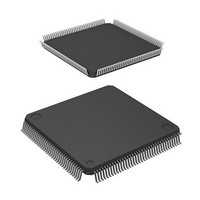D12674RVFQ33D Renesas Electronics America, D12674RVFQ33D Datasheet - Page 787

D12674RVFQ33D
Manufacturer Part Number
D12674RVFQ33D
Description
MCU 3V 0K I-TEMP 144-QFP
Manufacturer
Renesas Electronics America
Series
H8® H8S/2600r
Datasheet
1.D12674RVFQ33V.pdf
(981 pages)
Specifications of D12674RVFQ33D
Core Processor
H8S/2600
Core Size
16-Bit
Speed
33MHz
Connectivity
IrDA, SCI
Peripherals
DMA, POR, PWM, WDT
Number Of I /o
103
Program Memory Type
ROMless
Ram Size
32K x 8
Voltage - Supply (vcc/vdd)
3 V ~ 3.6 V
Data Converters
A/D 12x10b; D/A 4x8b
Oscillator Type
Internal
Operating Temperature
-40°C ~ 85°C
Package / Case
144-LQFP
Lead Free Status / RoHS Status
Contains lead / RoHS non-compliant
Eeprom Size
-
Program Memory Size
-
Other names
HD6412674RVFQ33D
HD6412674RVFQ33D
HD6412674RVFQ33D
Available stocks
Company
Part Number
Manufacturer
Quantity
Price
Company:
Part Number:
D12674RVFQ33DV
Manufacturer:
Renesas Electronics America
Quantity:
10 000
- Current page: 787 of 981
- Download datasheet (6Mb)
Section 15 Serial Communication Interface (SCI, IrDA)
In Smart Card interface mode, as in normal serial communication interface mode, transfer can be
carried out using the DTC or DMAC. In transmit operations, the TDRE flag is also set to 1 at the
same time as the TEND flag in SSR, and a TXI interrupt is generated. If the TXI request is
designated beforehand as a DTC or DMAC activation source, the DTC or DMAC will be activated
by the TXI request, and transfer of the transmit data will be carried out. The TDRE and TEND
flags are automatically cleared to 0 when data transfer is performed by the DTC or DMAC. In the
event of an error, the SCI retransmits the same data automatically. During this period, the TEND
flag remains cleared to 0 and the DTC or DMAC is not activated. Therefore, the SCI and DTC or
DMAC will automatically transmit the specified number of bytes in the event of an error,
including retransmission. However, the ERS flag is not cleared automatically when an error
occurs, and so the RIE bit should be set to 1 beforehand so that an ERI request will be generated in
the event of an error, and the ERS flag will be cleared.
When performing transfer using the DTC or DMAC, it is essential to set and enable the DTC or
DMAC before carrying out SCI setting. For details on the DTC or DMAC setting procedures,
refer to section 9, Data Transfer Controller (DTC) or section 7, DMA Controller (DMAC).
In receive operations, an RXI interrupt request is generated when the RDRF flag in SSR is set to
1. If the RXI request is designated beforehand as a DTC or DMAC activation source, the DTC or
DMAC will be activated by the RXI request, and transfer of the receive data will be carried out.
The RDRF flag is cleared to 0 automatically when data transfer is performed by the DTC or
DMAC. If an error occurs, an error flag is set but the RDRF flag is not. Consequently, the DTC or
DMAC is not activated, but instead, an ERI interrupt request is sent to the CPU. Therefore, the
error flag should be cleared.
15.10
Usage Notes
15.10.1 Module Stop Mode Setting
SCI operation can be disabled or enabled using the module stop control register. The initial setting
is for SCI operation to be halted. Register access is enabled by clearing module stop mode. For
details, refer to section 22, Power-Down Modes.
15.10.2 Break Detection and Processing
When framing error detection is performed, a break can be detected by reading the RxD pin value
directly. In a break, the input from the RxD pin becomes all 0s, and so the FER flag is set, and the
PER flag may also be set. Note that, since the SCI continues the receive operation after receiving a
break, even if the FER flag is cleared to 0, it will be set to 1 again.
Rev. 3.00 Mar 17, 2006 page 735 of 926
REJ09B0283-0300
Related parts for D12674RVFQ33D
Image
Part Number
Description
Manufacturer
Datasheet
Request
R

Part Number:
Description:
CCD Vertical Clock Driver
Manufacturer:
Sony Corporation
Datasheet:

Part Number:
Description:
KIT STARTER FOR M16C/29
Manufacturer:
Renesas Electronics America
Datasheet:

Part Number:
Description:
KIT STARTER FOR R8C/2D
Manufacturer:
Renesas Electronics America
Datasheet:

Part Number:
Description:
R0K33062P STARTER KIT
Manufacturer:
Renesas Electronics America
Datasheet:

Part Number:
Description:
KIT STARTER FOR R8C/23 E8A
Manufacturer:
Renesas Electronics America
Datasheet:

Part Number:
Description:
KIT STARTER FOR R8C/25
Manufacturer:
Renesas Electronics America
Datasheet:

Part Number:
Description:
KIT STARTER H8S2456 SHARPE DSPLY
Manufacturer:
Renesas Electronics America
Datasheet:

Part Number:
Description:
KIT STARTER FOR R8C38C
Manufacturer:
Renesas Electronics America
Datasheet:

Part Number:
Description:
KIT STARTER FOR R8C35C
Manufacturer:
Renesas Electronics America
Datasheet:

Part Number:
Description:
KIT STARTER FOR R8CL3AC+LCD APPS
Manufacturer:
Renesas Electronics America
Datasheet:

Part Number:
Description:
KIT STARTER FOR RX610
Manufacturer:
Renesas Electronics America
Datasheet:

Part Number:
Description:
KIT STARTER FOR R32C/118
Manufacturer:
Renesas Electronics America
Datasheet:

Part Number:
Description:
KIT DEV RSK-R8C/26-29
Manufacturer:
Renesas Electronics America
Datasheet:

Part Number:
Description:
KIT STARTER FOR SH7124
Manufacturer:
Renesas Electronics America
Datasheet:

Part Number:
Description:
KIT STARTER FOR H8SX/1622
Manufacturer:
Renesas Electronics America
Datasheet:











